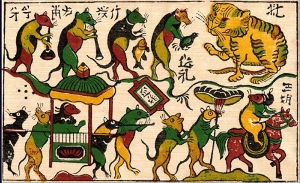Đông Hồ Painting Village
VGP - Đông Hồ painting is printed by hand on the surface of wooden plate. Each printing color has its own engraved board. The black one is printed last. Thanks to this way, paintings are made in bulk and do not require sophisticated techniques.
 |
|
Đông Hồ Painting – Illustration photo |
Đông Hồ is located on the southern side of the Đuống river (40 km to the east of Hà Nội) is one of the villages that preserves ancient cultural relics of Kinh Bắc area (Red river delta, north of Việt Nam).
Đông Hồ paintings mainly reflect the aspiration for a peaceful, happy and prosperous life. Dear animals in people’s life, such as cow, pig, dog, cat and chicken are also depicted in a lot of paintings. Especially, some paintings like “catching coconuts”, “mice wedding” and “jealously” attract the attention of many domestic and foreign visitors.
The painting fair is annually held on Tết holiday in the communal house in Đông Hồ village, which draws a large number of tourists. From the afternoon of March 14th (lunar calendar), shoddy goods competition is also held at the same place. Painting fair is a distinctive cultural feature of Đông Hồ villagers.
The printing paper is made from the bark of a tree called Gió. The background paper is originally white. People use natural materials to change the colors of the paper which are usually orange, pink, yellow, purple, etc. colors of the paintings are refined from various kinds of tree leaves that can be easily found in Việt Nam.
Particularly, the red color is taken from earth of hills and mountains; the black color is from the coal of burned bamboo's leaves; the glitter white color is made of sea shells. The original point of Đông Hồ folk painting is the durability of colors. The painting is finally covered with a layer of sticky rice paste (called hồ nếp) to protect the paintings and their colors. They are so long lasting that it is very difficult to make them dimmer due to time or light.
The most common idea carries congratulation meanings, for instance, “Honor-Prosperity”, “Spring Ritual”, “Chicken Family”. Another plot is daily activities, which include “Jealously”, “Playing flute”, “Farmer and Water Buffalo”. Those paintings with Chinese characters have clearer meanings. For example, the painting “Justice” that portraits a child carrying a frog, which means humanity and justice.
Remember to come to Đông Hồ on Tết holiday to mingle yourselves in the atmosphere of a painting fair, which is an opportunity to choose one to your taste./.

